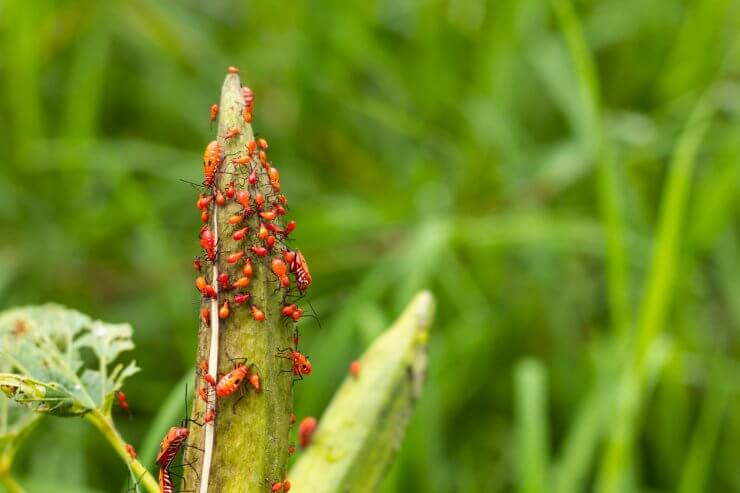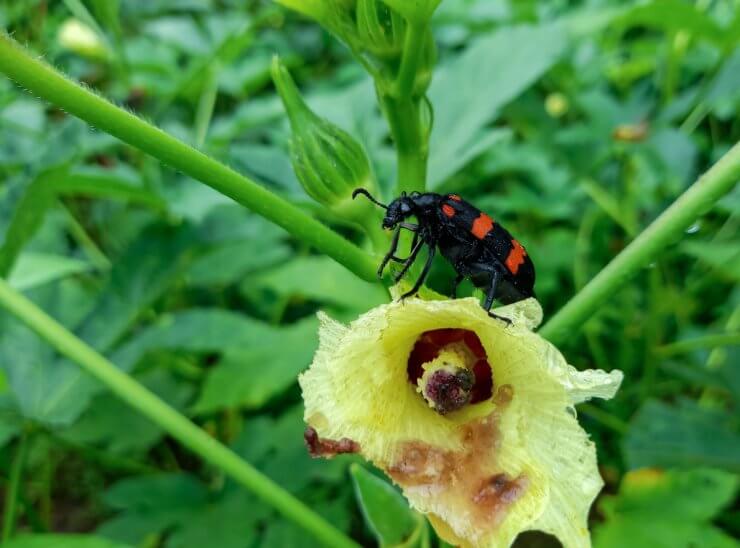
Pests attacking okra plant
There’s good news and bad news about okra pests. For the most part, pests that munch on your okra plant’s leaves are annoying but won’t likely be fatal to your crop. The bad news is that there are other pests that can wreak havoc with your harvest.
It always pays to be vigilant. Plan daily inspections of your plants to guard their health. Things to watch out for:
Pests that Chew
Corn Earworm: eats holes in okra pods. Young earworms are cream colored or light yellow-green; old earworms are green or brown with stripes or spots.
Japanese Beetle: likes to eat pods and leaves. Hard, metallic green body with copper-colored wing covers.
Slugs: they just like to eat. Look for their shiny, slimy bodies near the base of the plants.
Pests that Cause Discoloration and Damage
Aphids: winged or wingless, aphids feed in colonies. They leave behind a liquid called honeydew, which encourages the growth of sooty mold.
Stink bugs and Leaf footed bugs: bore into pods. Seeds will shrivel, and wart-like growths will appear on the pods.
Pests that Burrow into the Plant
European corn borer: pale yellow or pink caterpillar. Bores into the stem, weakening the plant and interrupting the development of pods.
Vegetable leafminer: a little colorless or white maggot with black mouth parts. Bores into leaves with its pointed head, leaving S-shaped scars in the leaves.
Root knot nematode: these tiny worms can decimate the root system of the okra plant and kill it. They burrow into the roots and lay their eggs there. The feeder roots start to die off, and swollen galls form. Nematodes thrive in the same hot conditions that okra likes.
How to deal with pests on okra plants

Hycleus beetle on okra flower
Here are some proven ways to get rid of pests on your okra plants. Choose the best treatment for the type of pests invading your plants.
- Inspect plants regularly. Look for signs of feeding and for eggs on the undersides of plant leaves. Watch for “honeydew,” the liquid that aphids secrete; a secondary mold infection may be close behind.
- Set out traps. Set out traps for stink bugs. There are pheromone traps for stink bugs and other pests that will lure them in but won’t let them out. Place them among your plants and check them daily.
- Pick off the pests. Use your garden gloves to remove the pests by hand. After removal, destroy pests by drowning them in a bucket of soapy water or crushing them with your foot. With small (but numerous) pests like aphids, blast them with your garden hose, aimed at a bucket. After you’ve “harvested” the pests, add a little soap to the water and leave it out in the sun for the rest of the day, then dump it.
- Apply insecticidal soap. Insecticidal soap is organic. The potassium salts in insecticidal soap help remove an insect’s protective waxes, causing destruction of insect membranes and killing them. Insecticidal soaps are particularly effective on smaller pests. Mix the soap with water to create your solution and apply directly to insects on any plants. While insecticidal soap is less apt to affect other organisms, certain plants might be sensitive to the soap and can suffer leaf burn.
- Apply horticultural oils. Combine plant- or petroleum-based oils with water to produce horticultural sprays. Neem oil, for instance, is derived from seed extracts of the neem plant. Oil-based sprays block an insect’s air holes, interfere with an insect’s metabolism, disrupt insect feeding, and inhibit insect growth. Like insecticidal soaps, horticultural oils can cause plant injury if not properly diluted. This is a good remedy for weevils.
- Apply diatomaceous earth (DE). If you spot slugs, this substance on the ground around your plants will deter slugs, which don’t like to crawl over the DE. You can also lure them to their demise with a dish full of beer.
- Make your own pest spray. You can make your own pest spray with benign materials. Mix one tablespoon of baking soda, 1/2 teaspoon of a mild dish detergent, and 2 1/2 tablespoons of olive oil in a gallon of water to make a solution that will repel all kinds of bugs. Shake it well in your bottle before spraying and repeat every week for it to be continuously effective.
- Enlist natural enemies. Make your garden welcoming to toads and garter snakes; they’ll help control some of your pests. Ladybugs, praying mantis, spiders, and birds can also be beneficial allies in pest control.
- Consult your extension center or garden center. If you feel that none of these natural approaches is working, take clear pictures of your plants and their pests and get advice from a local expert.
Do pests attack your okra plants every year? How do you handle removing them—and even preventing them in the first place?


 Previous
Previous


Root Knot Nematodes can destroy your entire crop. When this happened to me, the next year, I heavily seeded the raised bed with common, ordinary marigolds. I then planted okra on the margins of the marigolds. The harvest was very good. 2-4 lbs of okra a day from a 4x8x32′ raised bed. Marigolds will absolutely control root knot nematodes.